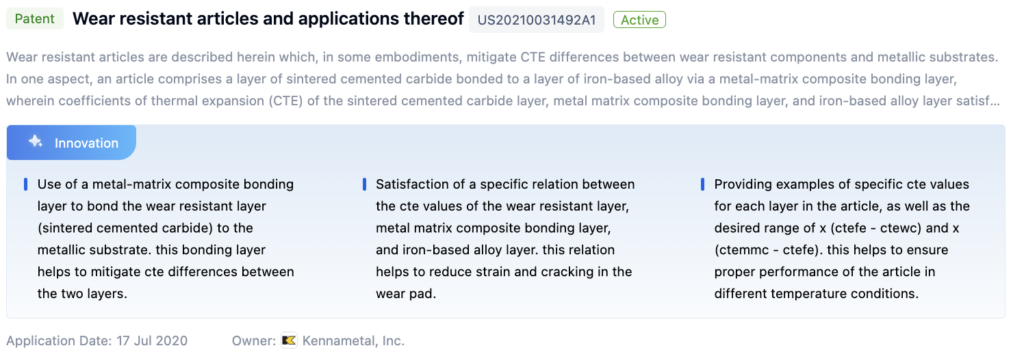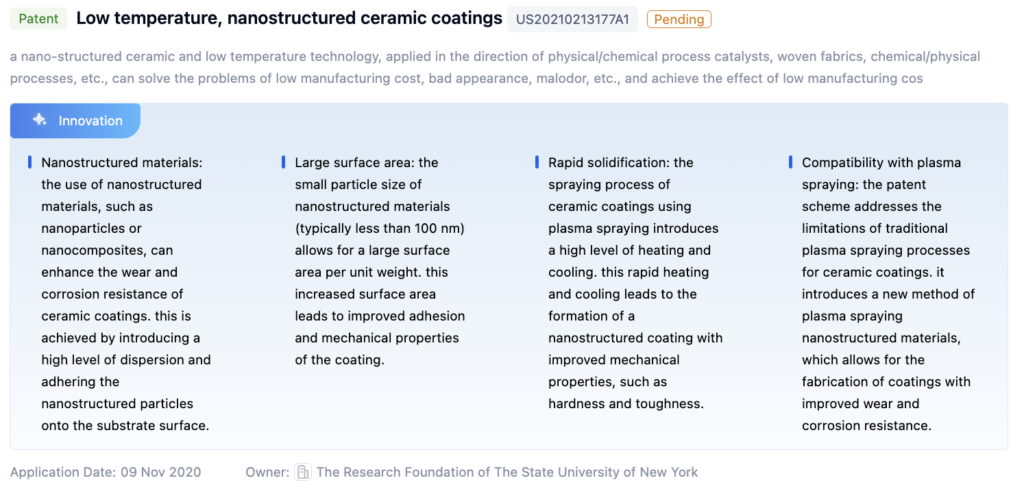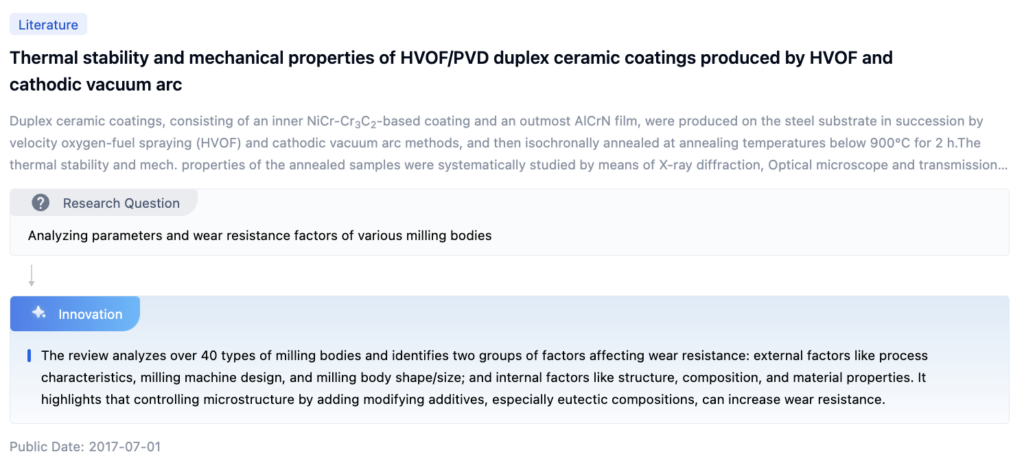
Ceramic Coating Technology Background and Goals
Ceramic coatings have emerged as a promising solution for enhancing the wear resistance and durability of various components and surfaces. Typically composed of materials like alumina, zirconia, or silicon carbide, these coatings offer exceptional hardness, chemical inertness, and resistance to high temperatures and abrasive environments.
The demand for wear-resistant ceramic coatings spans diverse industries, including aerospace, automotive, energy, and manufacturing. In aerospace, ceramic coatings protect turbine blades and engine components from erosion and corrosion caused by high-velocity particle impacts and extreme temperatures. In automotive applications, ceramic coatings are applied to engine components, piston rings, and cylinder liners to reduce friction and wear, improving fuel efficiency and extending component life.
The primary goal of research in this field is to enhance the wear resistance and durability of ceramic coatings while maintaining their desirable properties, such as hardness and thermal stability. Achieving this involves optimizing coating composition, improving adhesion to substrates, and developing advanced deposition techniques. Ongoing research focuses on developing nanostructured and composite ceramic coatings, incorporating reinforcing phases like carbon nanotubes or graphene to improve toughness and fracture resistance. Advances in deposition techniques, such as plasma spray, physical vapor deposition (PVD), and chemical vapor deposition (CVD), have enabled the production of high-quality ceramic coatings with tailored properties, allowing precise control over coating thickness, microstructure, and composition.

To get detailed scientific explanations of the ceramic coatings, try Patsnap Eureka TechResearch.
Market Demand for Wear-Resistant Coatings
The market demand for wear-resistant coatings is driven by industries requiring protection against abrasion, erosion, and corrosion for their components and equipment:
- Automotive and Transportation: Essential for engine cylinders, piston rings, valve train components, and heavy machinery, reducing friction and wear.
- Aerospace and Aviation: Critical for turbine blades, compressor components, and landing gear, requiring coatings that withstand extreme operating conditions.
- Energy and Power Generation: Used in power plants, wind turbines, and oil and gas equipment to prevent premature failure due to harsh environments.
- Manufacturing and Tooling: Applied to cutting tools, forming dies, and industrial components to enhance durability and performance.
- Biomedical and Healthcare: Enhances the longevity and biocompatibility of orthopedic implants, surgical instruments, and medical devices.
The need for improved component performance, extended service life, and reduced maintenance costs is driving the demand for advanced wear-resistant coatings, with a growing emphasis on sustainability and environmental regulations.
Current State and Challenges of Ceramic Coatings

Ceramic coatings are valued for their high hardness, wear resistance, and chemical inertness, but they face challenges that hinder their widespread adoption:
- Brittleness: While ceramics are hard, they often lack toughness, making them susceptible to cracking and chipping under mechanical loads.
- Adhesion Issues: Poor adhesion to substrates can result in delamination, compromising wear resistance.
- Thermal Stability: Maintaining structural integrity under high temperatures is crucial, as thermal cycling can induce stresses and degrade performance.
- Deposition Challenges: Techniques like PVD and CVD require specialized equipment and controlled environments, increasing manufacturing complexity and cost.
- Geographical Disparities: Uneven distribution of technology can hinder knowledge sharing and adoption.
Addressing these challenges requires a multidisciplinary approach, including materials science, surface engineering, and manufacturing processes.
Evolution of Ceramic Coating Technologies

Existing Solutions for Wear Resistance in Ceramic Coatings
Ceramic Coatings with Enhanced Wear Resistance
- Material Composition: Incorporating hard particles like carbides, nitrides, or oxides increases hardness and wear resistance. High-entropy alloys or nanostructured materials further enhance performance.
- Multilayer/Gradient Structures: Alternating layers of different materials provide a combination of wear resistance and toughness, while gradient coatings improve adhesion and wear resistance.
- Surface Modification: Techniques like nitriding, carburizing, or oxidizing enhance surface hardness, while methods like shot peening introduce compressive residual stresses to improve wear resistance.
- Composite Structures: Metal-ceramic, polymer-ceramic, or ceramic matrix composites offer a synergistic effect, enhancing wear resistance while maintaining other properties like toughness or thermal stability.
Preparation Methods for Wear-Resistant Ceramic Coatings
- Thermal Spraying: Techniques like plasma spraying or high-velocity oxy-fuel (HVOF) spraying deposit dense, adherent coatings with excellent wear resistance.
- Incorporation of Reinforcements: Adding particles or fibers like silicon carbide, alumina, or carbon fibers improves hardness, toughness, and wear performance.
- High-Entropy Ceramic Materials: Composed of multiple principal elements in equimolar ratios, these materials exhibit superior wear resistance.
- CVD/PVD Techniques: These allow precise control over coating composition and microstructure, resulting in improved wear resistance.
- Thermal Shock and Corrosion Resistance: Coatings designed for high-temperature applications must also resist thermal shock and corrosion.
Key Players in Ceramic Coating Industry
Murata Manufacturing Co. Ltd.
- Focus: Nanostructured materials for enhanced hardness and toughness, with a proprietary deposition process ensuring uniform thickness and strong adhesion.
Praxair S.T. Technology Inc.
- Focus: Plasma-sprayed ceramic coatings and HVOF spraying for wear and corrosion resistance.
Osaka Prefecture University
- Focus: Sol-gel techniques for coatings with nano-sized particles, enhancing mechanical properties.
Siemens Energy Global GmbH & Co. KG
- Focus: Thermal barrier coatings (TBCs) for turbine blades, applied using electron beam physical vapor deposition (EB-PVD) techniques.
Luoyang Institute of Science & Technology
- Focus: Composite coatings combining ceramics with other materials for improved wear resistance.
Core Innovations in Ceramic Coating Wear Resistance
Patent 1: Wear Resistant Articles and Applications Thereof
- Core Points:
- Metal-Matrix Composite Bonding Layer: Bonds sintered cemented carbide to metallic substrates, mitigating differences in coefficients of thermal expansion (CTE) to reduce strain and cracking.
- Specific CTE Relation: Ensures proper performance across different temperature conditions.

Patent 2: Low Temperature Nanostructured Ceramic Coatings
- Core Points:
- Nanostructured Materials: Enhance wear and corrosion resistance with high dispersion and adhesion of nanoparticles.
- Rapid Solidification: Plasma spraying leads to a nanostructured coating with improved hardness and toughness.

Paper 1: Thermal Stability and Mechanical Properties of HVOF/PVD Duplex Ceramic Coatings
- Core Points:
- Wear Resistance Factors: External factors like process characteristics and internal factors like material composition affect wear resistance.

Potential Breakthroughs in Ceramic Coating Technology
Enhanced Wear Resistance:
Various ceramic coating materials and compositions exhibit improved wear resistance properties for protection against abrasion, erosion, and other forms of wear.
Preparation Methods:
Techniques like specific processing steps, heat treatments, or the use of particular precursors or additives enhance wear resistance.
High-Temperature Applications:
Formulations that maintain wear-resistant properties at elevated temperatures, incorporating refractory materials or thermal barrier components.
Evaluation and Testing:
Methods for assessing wear resistance include specialized wear testing rigs, tribological analysis, and acoustic emission monitoring.
Multifunctional Coatings:
Coatings that combine wear resistance with additional properties like corrosion resistance, thermal insulation, or non-stick characteristics.
Environmental Impact of Ceramic Coatings
The production of ceramic coatings involves energy-intensive processes that contribute to greenhouse gas emissions and resource depletion. However, during use, these coatings extend the lifespan of components, reducing material consumption and waste. Disposal challenges arise due to the non-biodegradable nature of ceramics, which can persist in the environment. Mitigation strategies include energy-efficient production, recycling, and exploring biodegradable or environmentally benign coatings.
Regulatory Landscape for Ceramic Coatings
Ceramic coatings are subject to various regulations focused on controlling hazardous substances, emissions, and worker safety. Compliance with industry standards ensures product quality, performance, and market acceptance. Companies must navigate a complex regulatory landscape, including international trade agreements, to maintain compliance and avoid penalties. Proactive adaptation to regulatory changes is essential for sustaining competitive advantage in the global market.
If you want in-depth research or a technical report, you can always get what you want in Patsnap Eureka TechResearch. Try now!

